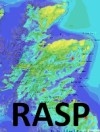What's all
this about?
The club was formed in February 1975 by a number of pilots who had been flying the Tinto area since February 1974.
For
those who dream of soaring like a bird, hang
gliding and paragliding
are the cheapest and simplest ways to get into
the air. Both
aircraft are foot launched and highly
maneuverable to allow the pilots
to make the most of the natural rising currents
of air which are their
only source of lift. No noise or pollution
is involved - these are
truly environmentally friendly sports, entirely
powered by the sun and
the wind. Expert pilots who know how to
exploit these natural
phenomena can travel incredible distances.
Current Scottish XC
(cross country) record is over 200 km!
What is a paraglider?
A
paraglider is a fabric canopy, like a parachute, but designed to fly
off hills rather than open up in free fall. Being designed for
soaring flight, it has much better gliding performance than any
parachute.
What is
a hang glider?
A hang glider is a semi-rigid wing - fabric sail with an airframe made of aluminium tubes and steel cables.
What
is better, a paraglider or a hanglider?
It's
about the same as skiing and snowboarding - two fairly similar sports
sharing a slope. Paragliders offer quicker initial training, are
easier to carry and quicker to get ready to fly. Hangliders are
bulkier and take longer to rig, require more initial training but offer
higher speed and better glide.
There are
people doing both hangliding and paragliding -
they choose the gear
depending on weather and flying site -
paraglider kit for very light
days or for a long carry-up, hanglider for
windier or rough days, or
when it's easy to drive to take-off and landing.
Looking
at another angle, on average paraglider pilots
tend to be younger than
hanglider pilots, and female percentage is
higher in paragliding than in
hangliding.
Is it
dangerous?
There
is some risk, as in any other kind of aviation. However the old
days are over, now it's not nearly as dangerous as in pioneer years.
Hang gliders and paragliders are tested for stability and
strength, and certified. Statistically hangliding and paragliding
are about as risky as riding motobikes or skiing, but those risks are
less random - a pilot usually knows when he's about to take a risk, and
usually has an option to avoid it.
Where is
the engine?
It's
like skiing, there's no engine. Gliders (hangliders, paragliders
and sailplanes) may need initial boost to get off the ground (most often
we use hills for that), and then fly on the natural energy of moving
air - wind and sun provide enough to fly for hours and cover more than
100km. Using this energy requires some intelligence though, and
that's what one learns after initial training. There are
foot-launched powered machines - paramotors and motorized hangliders and
we have a few pilots in our club who fly them as well as free-flight
gliders.
Do
you jump off mountains?
Not
quite, hanglider and paraglider pilots perform controlled take-off, the
wing starts to fly and create lift while pilot's feet are on the
ground.
There are other ways to get off
the ground - towing by a winch or by a
microlight aircraft, or dropping
from a hot air balloon. Still, launching
from a hill is the most
popular and the other ways are used where there
are no hills.
Don't
your hands get tired of hanging on, how long can
you last?
Pilots
don't hang on with their hands, they sit or lie, strapped in a harness
which is connected to the wing. Hands are used for control, as
relaxed as when you drive. And you can let go for a while when
there's no traffic around! So we usually fly fairly relaxed, and flying
for more than 2 hours is a norm, sometimes a flight can last for 5
hours!
How
do you control these gliders?
A
paraglider is controlled with the brakes. You pull the left
handle - left hand side of the canopy slows down, and the glider turns
left. Pull the right one - it turns right. Pull them both -
it slows down. Still, if you don't get proper initial training
because you think it's THAT SIMPLE, give it a go and unknowingly do it
wrong - you may need a surgeon service or worse. A paraglider is
an aircraft, after all, and deserves respect.
A
hanglider is controlled by shifting pilots body,
this is called weight
shift control. You move youself to the
right in the control frame -
it turns right. Move yourself to the left
- it turns left.
Move yourself forwards - it flies faster.
Backwards - it
slows down. Proper initial training is
even more essential than
with paragliders.
What's
that beeping you make in flight and on the hill?
Hanglider
and paraglider pilots use instruments called "vario" which is a short
form of variometer. These tell you how fast you're going up or
down. And just in case you're not looking at the screen, they beep
when you go up, and burrr when you go down faster than normal.
Most of instruments also tell you how high you are.
Can
I learn to fly in your club?
Unfortunately, no. There are hangliding and paragliding schools for the initial training.
They teach the basics in a very safe environment, and issue Club
Pilot rating. Initial training takes approximately 10 flying days.
The more intensively one attends, the less he/she forgets between
the lessons, and requires fewer days in total. As you master
takeoffs, landings, turns and basic soaring - you get your CP (Club
Pilot) rating and then join a club.
Every club has a few active experienced pilots
called Coaches (see our
Coaches
page)
who are happy to advice novice pilots, wouldn't
mind coming out to fly
with you, and sometimes give lectures on club
nights in winter.
Being a glider pilot is not a destination,
it's a path! One never
stops learning to be safer and better pilot.
How
expensive is it?
Fairly expensive to start, much easier after. Some rough figures:
School day
90 quid.
Whole courses cost
approximately £500 for EP (elementary pilot,
first stage of training)
and similar amount for CP (club pilot, the
second stage of training).
Some clubs offer deals when you sign up
for both stages.
Typically you need 7 days at least if you do
very well, usually more
than 10. If you're paying per-day and
struggle on financial side
but have plenty time, here is a cheat for you:
good instructors don't
mind if you come along when they teach other
students, even if you don't
pay. Hang about, listen, help if needed
and you get almost as
much knowledge as paying students, and may get a
free ride or two for
your help.
Gear
£1500+
decent second hand kit, or £3000+ all brand new.
That's your wing,
harness, instruments and helmet. Buy it
after most of (if not
all) initial training in school.
BHPA membership
~£100 a year, includes 3rd party insurance
Club membership
£10 - £40 a year
New toys
Typically
from £100 to as much as you can spend - just
like with any hobby!
Instruments last you until you break it or
lose it.
New glider
£2000
- £4000 and lasts a few years. New
paragliders cost a little less
than new hangliders, and live 3-5 years, depends
on flying hours and
UV(sun) exposure.
Glider checks
These
have to be carried out once every 1 or 2 years -
it is specified by the
manufacturer. Usually it costs under £100
including courier for
posting your kit to and from the service.
New harness
From
£400 to up to a £1000, lasts up to 10 years.
A harness for the
first years of your career is likely to be the
cheaper one - the most
expensive models are typically for serious XC
and competition pilots.
It
is worth remembering that there is a lot of decent second hand gear
available and at the start of your flying career you won't need the most
expensive instruments or harness.
Can
I see how you guys fly before I decide to commit
my time and money to training?
Of
course! Check the message board, club members often discuss where to go
for flying. Get a mobile number for some active pilot if you can,
you'll be informed on the day or the day before. Hanglider and
paraglider pilots usually treat anyone who is interested in flying as a
friend.
Can
I have a ride on a two-seat glider with a
qualified pilot?
Yes,
there are two seat (tandem) hangliders and paragliders, and some pilots
in our club have those and are qualified to fly with a passenger.
Enquire at the message board or ask some club member you have
contacts for. Be prepared to go on a flyable day rather than when
you wish!
Alternatively, try a
hangliding or paragliding school, many of them
do tandem rides
commercially as a "lesson" and will normally
charge something between
£50 and £100.
Your flight will likely be
soaring, i.e. a pilot can stay in the air as
long as you wish or till
he's late for dinner. Sometimes
first-timers will have had enough
adrenaline after an hour of flying.
Have a question that's not here?
Email us!





